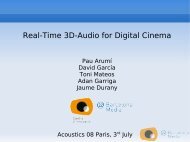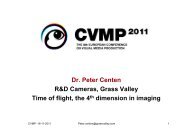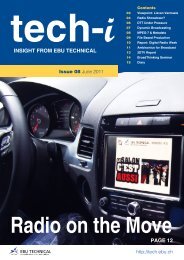Figure 5. Collision detection overview (a) input, a virtual object we want to check collision with (b) the virtual object converted into apoint cloud (c) the point cloud is projected onto the demultiplexed shadows of the real object (d) red points are inside every silhouette afterprojection, while blue points are projected outside at least one silhouette.5.3. ApplicationsIn this section we will demonstrate the usefulness of ourmethod <strong>for</strong> interactive collision detection. The first applicationshows how we can reconstruct a visual hull from thesesilhouettes, which can then be used <strong>for</strong> collision detectionwith virtual objects. As a second application we show howthe silhouettes can be used <strong>for</strong> collision detection in imagespace.5.3.1 Visual Hull ReconstructionFigure 6. Artifacts due to (a) specular reflections and (b) refractionswill break down <strong>for</strong> mainly transparent materials. Occasionallysmall artefacts appear when highly specular materialsreflect their light directly toward the surface as shownin Figure 6.5.1.4 Blue-Green Response OverlapBecause we do not use a multispectral camera, the numberof multiplexed blue and green LED intensities was limitedby two per light source. This is due to the large responseoverlap between green and blue on CCD cameras. This isillustrated in Figure 3.5.2. TimingsThe method is implemented on an NVidia GForce 8800GTX. We store up to 4 silhouettes into a single texture, reducingrequired memory storage. It also takes advantage ofthe scalar processors. The number of render passes is alsoreduced by 4 and the erosion and dilation can be calculatedsimultaneously. For input images containing 6 silhouetteswith a resolution of 640 ×480 we achieve a framerate of 40fps.The visual hull of the object can be reconstructed usingclassical shape-from-silhouette techniques. Because thesemethods usually require silhouettes from the viewpoint ofmultiple cameras we have to per<strong>for</strong>m a trans<strong>for</strong>mation onthe demultiplexed shadow. Since the setup is calibrated wecan use projective texture mapping <strong>for</strong> an efficient trans<strong>for</strong>mation.We model the diffuser on which we project ourmultiplexed shadows. Then we render it from the positionof the light source. Because the shadows are already demultiplexedon the GPU, this step can easily and efficiently beadded. An overview of this method is shown in the teaserimage.5.3.2 Image-Based Collision DetectionCollision detection can also be done directly in image space.There<strong>for</strong>e we divide our virtual objects into small voxelsand project each voxel onto the input image. We can thendetermine if this voxel is projected inside or outside the realobject’s silhouette. When a projection falls inside every silhouette,we assume a collision has occured. This way collisionresponse can be handled directly in image space. Thisis similar to the work of De Decker et al. [8] . An overviewof this method is shown in Figure 5.6. ConclusionWe proposed a technique to efficiently obtain multiplefull resolution silhouettes of an object from multiplexedshadows using a single camera, allowing to construct a visualhull or provide image based collision detection in realtimeon a single pc. Because only one camera is required,
no synchronization is needed and less data has to be obtainedand processed, increasing the per<strong>for</strong>mance and accuracy.Furthermore, easy and robust background subtractionis achieved <strong>for</strong> a variety of object materials.7. Future WorkCurrently we manually control the intensities of ourLEDs. We are working on a computer-controlled LEDdriver to automate LED intensity calibration, providing amore accurately tuned configuration.In order to increase the number of silhouettes in our prototype,we are looking to replace the RGB camera with amultispectral camera since some of the method’s potentialis lost due to the considerable blue-green response overlapof RGB cameras.AcknowledgementsThe authors (Cuypers Tom and Philippe Bekaert) acknowledgefinancial support by the European Commission(FP7 IP ” 2020 3D media”). We gratefully expressour gratitude to the European Regional Development Fund(ERDF), the Flemish Government and the Flemish Interdisciplinaryinstitute <strong>for</strong> Broadband Technology (IBBT),which are funding part of the research at the Expertise Centre<strong>for</strong> Digital Media. We also would like to thank our colleagues<strong>for</strong> their time and ef<strong>for</strong>t in this work.References[1] S. Balcisoy and D. Thalmann. Interaction between real andvirtual humans in augmented reality. In CA 1997, page 31,1997. 2[2] B. G. Baumgart. Geometric modeling <strong>for</strong> computer vision.PhD thesis, Stan<strong>for</strong>d University, Stan<strong>for</strong>d, CA, USA, 1974.1[3] J.-Y. Bouguet. Camera calibration toolbox <strong>for</strong> matlab, 2006.http://www.vision.caltech.edu/bouguetj/calib doc/. 5[4] K. Cheung, T. Kanade, J. Bouguet, and M. Holler. A realtime system <strong>for</strong> robust 3d voxel reconstruction of human motions.In CVPR 2000, pages 714 – 720, 2000. 2[5] S. S. Cheung and C. Kamath. Robust techniques <strong>for</strong> backgroundsubtraction in urban traffic video. Proceedings ofVideo Communications and Image Processing, pages 881–892, 2004. 2[6] T. Cuypers, Y. Francken, and P. Bekaert. <strong>Shadow</strong> multiplexing<strong>for</strong> single camera visual hull reconstruction. In PRO-CAMS ’08: Proceedings of the 5th ACM/IEEE InternationalWorkshop on Projector camera systems, pages 1–2, 2008. 1,2[7] T. Cuypers, C. Vanacken, Y. Francken, F. V. Reeth, andP. Bekaert. A multi-camera framework <strong>for</strong> interactivevideogames. In GRAPP 2008, pages 443–449, 2008. 2[8] B. D. Decker, T. Mertens, and P. Bekaert. Interactive collisiondetection <strong>for</strong> free-viewpoint video. In GRAPP 2007,pages 114–120, 2007. 2, 6[9] Y. Francken, T. Cuypers, T. Mertens, J. Gielis, andP. Bekaert. High quality mesostructure acquisition usingspecularities. In CVPR 2008, pages 1–7, 2008. 2[10] R. I. Hartley and A. Zisserman. Multiple View Geometryin Computer Vision. Cambridge University Press, secondedition, 2004. 5[11] J.-M. Hasenfratz, M. Lapierre, and F. Sillion. A real-timesystem <strong>for</strong> full body interaction with virtual worlds. EurographicsSymposium on Virtual Environments, pages 147–156, 2004. 2[12] M. Hatzitheodorou. Shape from shadows. Journal of Complexity,pages 63–84, 1998. 2[13] B. Horn. Obtaining shape from shading in<strong>for</strong>mation. In ThePsychology of Computer Vision, pages 115–155, 1975. 2[14] P.-H. Huang and S.-H. Lai. Contour-based structure fromreflection. CVPR 2006, pages 379–386, 2006. 2[15] H. Kawasaki, R. Furukawa, R. Sagawa, and Y. Yagi. Dynamicscene shape reconstruction using a single structuredlight pattern. In CVPR 2008, pages 1–8, 2008. 2[16] D. Lanman, R. Raskar, A. Agrawal, and G. Taubin. Shieldfields: Modeling and capturing 3d occluders. SIGGRAPHAsia 2008, 27(5), 2008. 1, 2[17] A. Laurentini. The visual hull concept <strong>for</strong> silhouette-basedimage understanding. IEEE PAMI 1994, pages 150–162,1994. 1[18] B. Lok, S. Naik, M. Whitton, and J. F.P. Brooks. Incorporatingdynamic real objects into immersive virtual environments.In I3D 2003, pages 31–40, 2003. 2[19] A. M. McIvor. Background subtraction techniques. Imageand Vision Computing, 2000. 2[20] Osram. Osram opto semiconductors - products, 2008.http://www.osram-os.com/osram os/EN/Products. 4[21] PointGreyResearch. Imaging products - grasshopper, 2008.http://www.ptgrey.com/products/grasshopper. 4[22] S. Savarese, H. Rushmeier, F. Bernardini, and P. Perona.<strong>Shadow</strong> carving. ICCV 2001, pages 190–197, 2001. 1, 2[23] D. Scharstein and R. Szeliski. High-accuracy stereo depthmaps using structured light. CVPR 2003, pages 195–202,2003. 2, 5[24] Y. Schechner, S. Nayar, and P. Belhumeur. A theory of multiplexedillumination. ICCV 2003, pages 808–815, 2003. 3[25] A. R. Smith and J. F. Blinn. Blue screen matting. In SIG-GRAPH 1996, pages 259–268, 1996. 2[26] R. Woodham. Photometric method <strong>for</strong> determining surfaceorientation from multiple images. Optical Engineering,pages 139–144, 1980. 2[27] S. Yamazaki, S. G. Narasimhan, S. Baker, and T. Kanade.Coplanar shadowgrams <strong>for</strong> acquiring visual hulls of intricateobjects. In ICCV 2007, pages 1–8, 2007. 1, 2, 5





